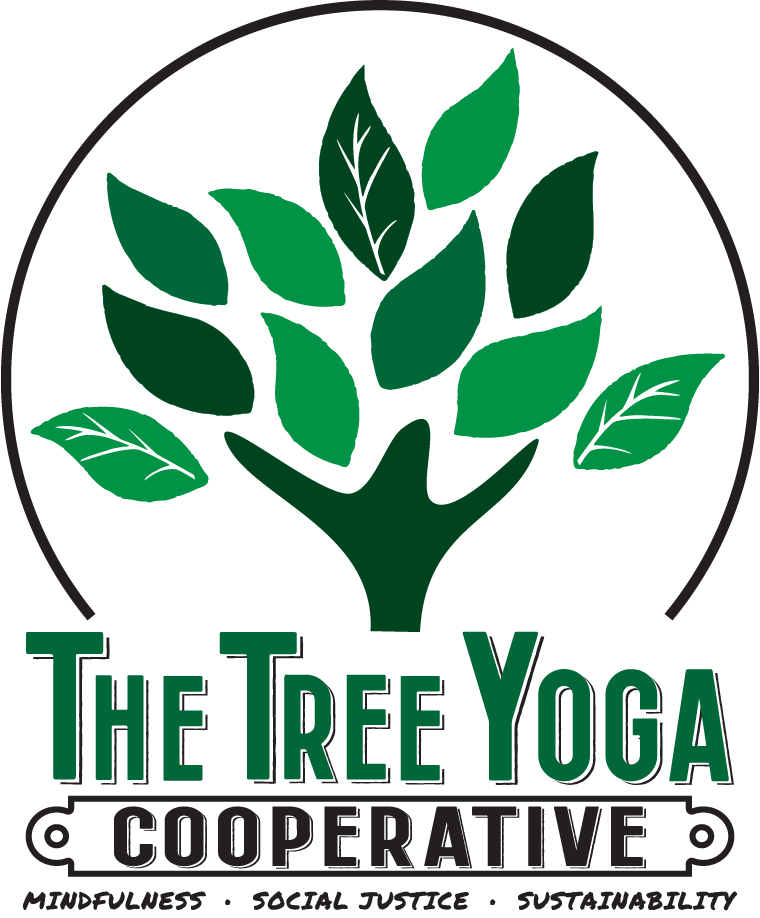Week Eight
It is week 8 here at the The Tree’s 2021 Spring YTT and we are more than halfway through our sessions together!
SATURDAY
We opened our Saturday class with the now very familiar opening circle. As the weeks have progressed the ritual of the Opening Circle has become a familiar resting place for us students in this cohort — an opportunity to share and be heard in ways that are not often available in our day to day comings and goings.
Pictured above, excerpts from our Spring 2021 YTT manual featuring the twisting postures we studied on Saturday.
Normally, during our asana breakdown our trainers will walk us through how to get into and out of the asana in question. Because we perform these postures outside the context of a full flow class, several students of the cohort found it difficult to pop up into a Revolved Half Moon without a warmup. This challenge sparked a class conversation on various strategies of where to place certain postures within a sequence. Our trainers noted that for twisting postures in general it’s good to make sure the spine is warmed up with some flexion and extension exercises (bending forward and back). For the past three weeks our homework assignments have grown to include practice-teaching a 30 minute sequence to friends and family. At this point in our training sessions our focus is not only on absorbing information but on flexing our teaching muscles and sharing what we have learned. The YTT classroom has now become a place to experiment with our own approach to teaching yoga. The practice-teach homework has given the class greater perspective on how to design sequences.
We got a chance to practice these skills in Saturday’s session with another practice-teach exercise. This time we took our written homework sequences (prepared ahead of time) and used it to teach a fellow student — with a third student as a neutral observer. Though these exercises continue to be a challenge for us students in the cohort, as one student noted, it has become an opportunity to observe our own strengths and weaknesses… it’s all a learning experience.
SUNDAY
The asanas we covered during the first portion of Sunday’s session included a variety of backbends and heart opening postures. Because the spine can be especially vulnerable in these poses, our class conversation focused on how to caretake the spine through these shape changes. Our trainers, Jana and J, reminded the class that it is key to give our own students space to move through these challenging postures at their own pace, in their own way.
Picture above, one of the heart-opening postures we covered during this Sunday’s asana analysis.
During the second half of Sunday’s class, guest lecturer Jasmine Allen — another friend of The Tree, yoga instructor, and educator — gave her presentation on the subject of Trauma-Informed Yoga.
But how does trauma relate to a yoga practice? During her talk, Jasmine broke down the origins of trauma. Trauma can be defined as any experience (physical, emotional, psychological) that overwhelms an individual’s capacity to cope. Our ability to cope is mediated by the parasympathetic nervous system — a system which brings the body out of fight-or-flight mode and into a state of rest-and-digest. If the nervous system is overwhelmed frequently enough (especially during an individual’s developmental years) it can have negative physical, mental, emotional, and even spiritual ramifications. This is where yoga can come in to assist the healing process. Yoga, and its emphasis on the mind-body connection, can address these nervous system imbalances by stimulating the rest-and-digest nervous system response. However, Jasmine reminded us that although yoga can be healing, we must bring a trauma informed perspective to our teaching practice.
Language plays an important role in leading a trauma informed practice. This means that cues from the teacher to the student should be invitational rather than imperative — empowering the student to decide how they want to take part in the practice. And this is just one of the many considerations one must take into account in order to be trauma informed. Overall, our presenter, Jasmine, emphasized that the student’s emotional and physical safety is the priority, not necessarily the asana practice itself. As yoga practitioners and teachers we have the opportunity to provide our students with tools to help repair a dysregulated nervous system and a trauma informed approach can deepen this practice.
WEDNESDAY
Santosha, or contentment, is the second niyama we covered during our Wednesday evening class. One trainee raised the question of how we can possibly find contentment in a world full of injustice and traumatizing situations? This opened up a class discussion where folks seemed to have a lot to share. Students brought up their own challenges with contentment. Challenges due to racism, trauma, and adverse life experiences. The conversation got deep.
We discussed how there may be levels to the kinds of contentment we experience, how we may even find contentment in our malcontent — it may prompt us to take action we feel is necessary to change a situation. Each participant brought their own perspective of contentment to the conversation and created a space for passionate, honest group reflection. It was one of many fascinating discussions we’ve had in this YTT training.
NOW LET’S HEAR FROM THE CLASS!
— Dorian, Spring 2021 YTT trainee



